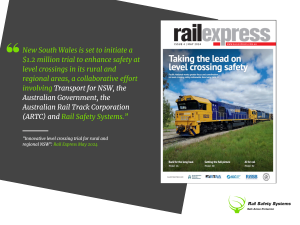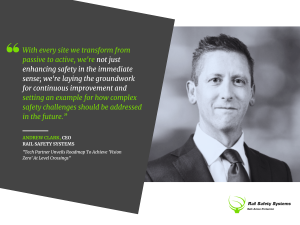In a pivotal move towards safer rail crossings, the technology provider responsible for a cutting-edge wireless solution has unveiled an ambitious roadmap aimed at achieving ‘Vision Zero’ – a future with zero harm at level crossings.
Rail Safety Systems (RSS) has developed a roadmap that reflects the findings of a level crossing safety roundtable held in Brisbane last month, prompted by the tragic loss of Pacific National drivers Kevin Baker and Mick Warren on New Year’s Eve.
Attended by government officials from Australia and New Zealand, along with industry representatives, academics and advocacy groups, the roundtable discussions centred around identifying priority actions that could lead to significant enhancements in level crossing safety.
Among the top priorities were leveraging innovation and emerging technologies for greater efficiencies and implementing a coordinated education and enforcement program to reduce poor motorist behaviour at level crossing sites.
RSS’s ‘Vision Zero’ Roadmap incorporates the full range of actions prioritised by the roundtable delegates, including RSS’s advanced rail signalling technology, which will be installed as part of a $1.2 million trial in New South Wales later this year.
RSS CEO Andrew Clark said a formal roadmap was necessary to provide clear direction to stakeholders of the actions necessary to transform level crossing safety, moving closer to the ultimate goal of zero harm.
“The roundtable in Brisbane was a cornerstone event, where stakeholders came together to help drive change by collating a priority action list, underpinned by data-driven analysis, that will lead to meaningful enhancements in level crossing safety throughout Australia.
“We’ve incorporated this action list, and flagged potential roadblocks alongside measures of success to ensure we clearly outline the steps necessary to realise ‘Vision Zero’,” Mr Clark said.
Key highlights of RSS’s ‘Vision Zero’ Roadmap include:
- Leveraging Innovation and Technology: Commitment to adoption of emerging technologies for upgrading level crossings. The innovative Rail Active Crossing System (RAXS), featuring solar power and modular design for rapid, cost-effective installation, is an example.
- Improving Education and Enforcement: Recognising that motorist behaviour is a critical factor in incidents at level crossings, implementing a coordinated national program that emphasises education and enforcement as areas for immediate action.
- Federal Funding: Securing access to federal grants to fund site upgrades within the 2023-2026 window.
- Collaborative Trials and MoU: Full participation in cross-type approval trials of emerging solutions, with accelerated access to National Type Approvals following successful trials.
- National Database: Establishing/Maintaining a national database for technology trials, efficacy study results, and other critical safety measure resources for ease of information sharing and collaboration.
“Naturally, at RSS, we believe in the power of innovation and technology to solve complex problems, and RAXS is a prime example of how creative thinking and technological advancements can be harnessed to improve safety at level crossings,” Mr Clark said.
“This system represents our commitment to not only addressing current safety challenges but also setting new standards for the industry.”
The ambitious roadmap defines success as the completion of 100 site upgrades from passive to active per year, supported by approved federal government funding and unwavering stakeholder commitment.
“Our definition of success goes beyond the mere completion of site upgrades; it encompasses the creation of a sustainable culture of innovation and collaboration.
“With every site we transform from passive to active, we’re not just enhancing safety in the immediate sense; we’re laying the groundwork for continuous improvement and setting an example for how complex safety challenges should be addressed in the future,” he said.








